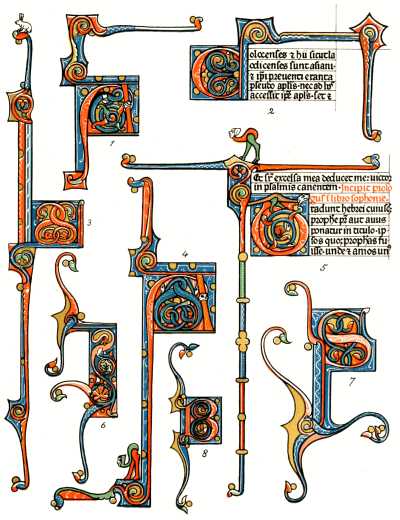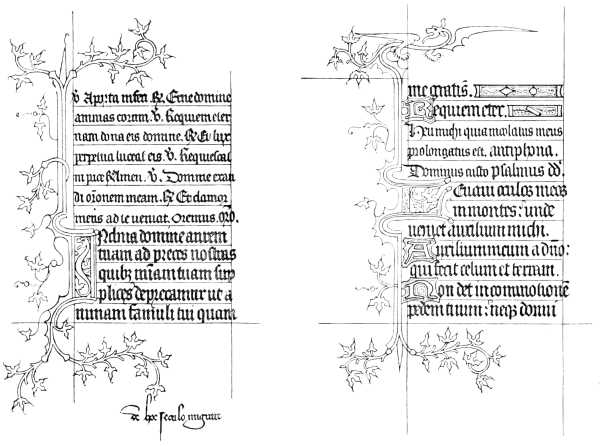

Left: Plate III. Examples of 13th Century Work. Right: Pages from a Book of Hours of Fourteenth Century from Lessons in the Art of Illuminating by W. J. Loftie. Source: Project Gutenberg EBook #40423 produced by Chris Curnow, Matthew Wheaton and the Online Distributed Proofreading Team. [Click on images to enlarge them.]
Description of Plate III

he beauty of the work executed in the thirteenth century in England, and that part of what is now France which then belonged to England, can hardly be exceeded. In this Plate are gathered a few examples of the period. They are from two books, both in the British Museum, but one probably written in France and the other at Canterbury. The initials from the French manuscript may be readily distinguished. The scroll-work is irregular and even wild, and in some examples the artist seems to have aimed at nothing less than startling the reader by his eccentricities. The volume is numbered in the Catalogue, Additional MSS. 11,698, and contains a treatise on the art of war. The letters numbered in the Plate 6, 7, and 8, are from this book. The student will observe the simple scale of harmonious coloring, blue predominating, as is necessary, and both yellow and also gold being used to heighten the effect. In copying them the artist used these colors, besides Chinese White and shell gold: namely, Prussian Blue, Lake, Indian Red, Emerald Green, Indian Yellow, shaded with Burnt Sienna, and Burnt Umber, with Sepia for the outlines. In imitating or copying these initials, the student will find a firm but delicate and even outline of the greatest importance. If the hand is very steady it may be put in with a small brush, which is particularly useful in the erratic flourishes in which this writer rejoiced so much.
The English letters are much more sober and rectilinear in character. The T (fig. 5) commences the prologue of the Book of Wisdom, for the volume is a Bible (Bibl. Reg. 1 D. 1), and a small portion of the text is given with the initial as a guide to the arrangement. The colors are the same as in the French examples. The lines and dots in white are very delicate, and may be closely imitated by the use of Chinese White with a very fine brush, care being taken not to disturb the underlying color. This is the book mentioned in the General Sketch as being the work of a writer named "Wills. Devoniensis," or William of Devonshire. It is a small folio in size and is written in double columns. At the commencement of the book of Psalms there is a magnificent illumination covering the greater part of the page, and showing, with much scroll-work by way of border, a series of small vignettes, which include a crucifixion, and a number of scenes from the life of St. Thomas of Canterbury, better known in history as Thomas Becket.
A somewhat similar Bible, but not so delicate in workmanship, is also in the British Museum (1 B. 12), and was written at Salisbury in 1254 by William de Hales.
The writing of the thirteenth century differs considerably from that of the two following centuries. It is not so stiff, but much more legible. The distinction will be apparent from a comparison of this Plate with those two which are copied from manuscripts at Lambeth (Plates IV. and IX.) Modern illuminators seem to have preferred the later style, but the advantages of the early should recommend it. The Chronicles written at St. Albans by and under the superintendence of Matthew Paris are all in this style. Facsimiles of several pages are given in the volumes published under the direction of the Master of the Rolls.
The initial T on the previous page is from a beautiful Nuremberg treatise of 1489 on the "Preservation of Body, Soul, Honour, and Goods."
On the back of Plate III. are two pages [see above right] in outline from a small Book of Hours in the collection of Robert Young, Esq., Belfast. This kind of work is known as the "Ivy Pattern." It was exclusively practised in France in the fourteenth century. The coloring is usually of a very sober character: the prevailing colors being blue and gold only.
References
Beckwith, Alice H. R. H. Victorian Bibliomania: The Illuminated Book in Nineteenth-Century Britain. Exhibition catalogue. Providence. Rhode Island: Museum of Art, Rhode Island School of Design, 1987.
Loftie, W. J. . Lessons in the Art of Illuminating: A Series of Examples selected from Works in the British Museum, Lambeth Palace Library, and the South Kensington Museum.. London: London: Blackie & Son, nd. “The Colored Illustrations are Printed by W. G. Blackie & Co., Glasgow, from Drawings by J. A. Burt.” Project Gutenberg EBook #40423 produced by Chris Curnow, Matthew Wheaton and the Online Distributed Proofreading Team. Web. 11 January 2014.
Last modified 11 January 2014